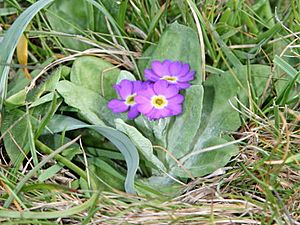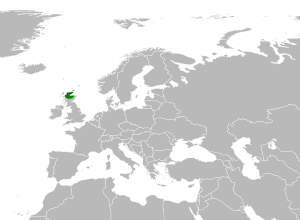Scottish primrose facts for kids
Quick facts for kids Scottish primrose |
|
|---|---|
 |
|
| Scientific classification | |
| Genus: |
Primula
|
| Species: |
scotica
|
 |
|
| The range of Primula scotica. | |
| Synonyms | |
|
Aleuritia scotica (Hook.) J. Sojak synonyms_ref = |
|
The Primula scotica, also known as the Scottish primrose, is a beautiful flowering plant. It belongs to the Primulaceae family, which includes all primroses. This special plant was found by James Smith, a Scottish botanist. It grows only in one specific area: the northern coast of Scotland. This means it is an endemic species, found nowhere else in the world naturally.
Contents
What the Scottish Primrose Looks Like
The Scottish primrose is a small plant that lives for about two years. It has stems and leaves that look like they are covered in a fine powder. Its leaves are widest in the middle and have smooth edges. They form a flat circle close to the ground, like a rosette.
When it blooms, the plant has purple flowers with a bright yellow center. Even when fully grown, this plant is only a few centimeters tall. The flowers are tiny, about 8 millimeters across. Each flower has five heart-shaped purple petals. In the middle of these petals is a clear yellow "eye."
Where the Scottish Primrose Grows
The Scottish primrose is found only in northern Scotland. You can see it along the northern coast of the mainland. This area includes parts of Highland (council area), specifically the old counties of Caithness and Sutherland. It also grows on the Orkney Islands, which are across the Pentland Firth.
In 2008, a study found the Scottish primrose in 194 different places. These locations stretched from Durness in Sutherland to Dunbeath in north-eastern Caithness.
Habitat and Life Cycle
The Scottish primrose likes to grow in coastal areas. It thrives in open grasslands and heathlands near the sea. Most of the places where this plant lives are only a few hundred meters from the ocean. These areas often have a mix of heath, grass, and rocky spots.
This plant can only make new plants from its seeds. It usually flowers twice a year. The first time is in early spring, and the second is in the summer. However, some plants might not flower at all.
The Scottish primrose usually reproduces by self-fertilisation. This means it uses its own pollen to make seeds. But if insects help to move pollen between different plants (cross-pollination), the new plants can be stronger and live longer. This plant needs short grass to survive. It can often grow in small patches of bare soil. For example, it might grow in marks left by animal hooves. Scottish primroses are perennial, meaning they can live for many years. Once they are mature, they can stay in a spot even if it becomes less suitable for new seeds to sprout. Very cold winters can cause many young plants to die.
How the Scottish Primrose is Related to Other Plants
The Scottish primrose is most closely related to another plant called Primula scandinavica. This relative grows in Norway and north-west Sweden. It is also distantly related to Primula stricta, which is an Arctic species.
Threats and Protecting This Plant
The Scottish primrose needs short plants around it to grow well. If there isn't enough grazing by animals, the grass can grow too tall. This makes the habitat unsuitable for the primrose. On the other hand, too much grazing can also harm the plants, especially if animals eat them.
Another problem is that some of its natural habitat has been lost. This is due to farming becoming more intense and new trees being planted. Climate change is also a threat. This plant is sensitive to very hot or very cold weather.
To protect this rare plant, a few special areas are being managed. This includes controlling how much animals graze. Such efforts help to keep this unique plant safe, as it does not have much genetic diversity.
Cultural Significance
The Primula scotica is the official county flower of Caithness. It was also the first symbol used by the Scottish Wildlife Trust.
See also
 In Spanish: Primula scotica para niños
In Spanish: Primula scotica para niños

